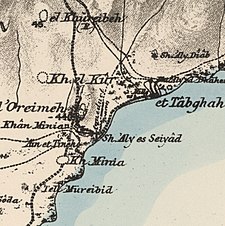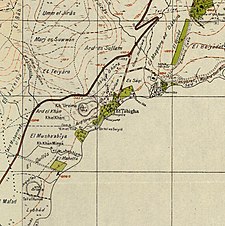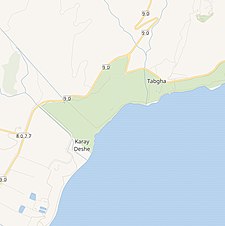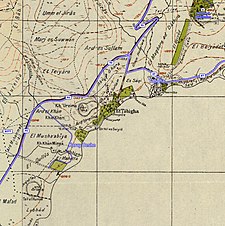Tabgha
Tabgha | ||
|---|---|---|
 Tabgha in 1903 | ||
| Etymology: From the Greek name "Heptapegon", lit. "seven springs". | ||
A series of historical maps of the area around Tabgha (click the buttons) | ||
Geopolitical entity Mandatory Palestine | | |
| Subdistrict | Tiberias | |
| Area | ||
| • Total | 5,389 dunams (5.389 km2 or 2.081 sq mi) | |
| Population (1945) | ||
| • Total | 330[1][2] | |
| ^ includes Tell el Hunud and Khan el Minya | ||


Tabgha (
Etymology
The site's name is derived from the Greek name Heptapegon ("seven springs"). The name was later shortened to "Tapego", and was eventually changed to "Tabgha" in Arabic, since
History
Byzantine period
In the Byzantine period, the water of the springs at Heptapegon was collected in three water towers (Birket Ali edh-Dhaher at Ein Nur Spring, Hammam Ayyub, and Tannur Ayub) and sent via an aqueduct to the Plain of Ginosar, where it was used for irrigation; the three towers seem to be recorded in the mosaic floor of the 5th-century Church of the Multiplication at Tabgha.[3][4]
A map from Napoleon's invasion of 1799 by Pierre Jacotin showed Tabgha, marked by the word Moulin (mill in French).[5]
The 4th-century tower-like octagonal reservoir at Ein Nur Spring and the aqueduct it connected to are traditionally attributed to Ali, a son of the 18th-century ruler Dhaher (or Zahir) al-Umar. The reservoir is locally known as Birket Ali edh-Dhaher, "Pool of Ali edh-Dhaher".
In 1881, the Palestine Exploration Fund's Survey of Western Palestine (SWP) stated that the masonry of the structures indicates an Arab origin, thus agreeing with this tradition.[6]
Crusader period
The area now taken by the Church of St Peter's Primacy was known during the Crusader period as Mensa Christi, or Mensa Domini.[7][8]
Ottoman period
In 1596, as Al-Tabigha was part of the
Johann Ludwig Burckhardt described the place as having a few houses and a mill, where the inhabitants were fishermen.[11]
In 1838 Edward Robinson found here a small village, with one or two mills, built by Zahir al-Umar, but by then belonging to the government.[12]
British Mandate period
In the 1922 census of Palestine, conducted by the British Mandate authorities, Tabagha had a population of 175; 157 Muslims and 18 Christians,[13] (17 Roman Catholics and one Syrian Catholic).[14] By the 1931 census the population had increased to 245; 223 Muslims, 21 Christians, and 1 Jew, in a total of 53 houses.[15]
The number of people had increased to 330; 310 Muslims and 20 Christians, when the last census was made in the 1945 statistics. That number included Tell el Hunud and Khan el Minya.[1] The total land area was 5 389 dunams.[2] In 1944/45 the village had 7 dunams used for citrus and bananas, 287 were plantations and irrigated land, 2,728 used for cereals,[16] while 2,367 dunams were classified as non-cultivable land.[17]
On May 4, 1948, in
Church of the Multiplication
The earliest building at Tabgha was a small chapel built in the 4th century A.D. (around 350) by the
]
In the same place (not far from Capernaum) facing the Sea of Galilee is a well watered land in which lush grasses grow, with numerous trees and palms. Nearby are seven springs which provide abundant water. In this fruitful garden Jesus fed five thousand people with five loaves of bread and two fish.[20]
The mosaic of the fish and loaves is laid next to a large rock, which has caused some New Testament scholars to speculate that the builders of the original church believed that Jesus stood on this rock when he blessed the fish and loaves just before the feeding of the crowd who had come to hear him.[citation needed]
The large monastery and a church were built in the fifth century. While some date the destruction of the site to the time of the Arab conquest, the church was most likely destroyed in 614 during the Persian invasion, for already in AD 670, Bishop Arculf had reported that only columns from the church remained. In any way, by the Crusader conquests the Byzantine site was forgotten, and rediscovered only in the 20th century.[citation needed]
The area's lands were bought in the 18th century by a
Today, the church and surrounding land are property of
]Arson attack
On 18 June 2015, members of
Church of the Primacy of St. Peter

The
Endemic blind shrimp at Tabgha pool
The
See also
- Khirbat al-Minya - Umayyad qasr ruins
- Kinneret (archaeological site) - biblical city which gave the Sea of Galilee its Hebrew name; now Tell el-'Oreimeh (Arabic) or Tel Kinrot (Hebrew)
- Sea of Galilee Boat - fishing boat from the 1st century CE, preserved in a museum at Kibbutz Ginosar
References
- ^ a b Government of Palestine, Department of Statistics, 1945, p. 12
- ^ a b c Government of Palestine, Department of Statistics. Village Statistics, April, 1945. Quoted in Hadawi, 1970, p. 73
- ^ [Stefano De Luca, Capernaum, paragraph on Tabgha, in The Oxford Encyclopedia of the Bible and Archaeology, vol. 1, p. 179, New York: Oxford Univ. Press, 2013]
- ISBN 0-691-00220-7. Retrieved 26 July 2016.
- ^ Karmon, 1960, p. 166 Archived 2019-12-22 at the Wayback Machine.
- ^ Conder and Kitchener, 1881, SWP I, p. 371
- ^ Khalidi, 1992, p. 542
- ^ Pringle, 1998, pp. 334- 339
- ^ Hütteroth and Abdulfattah, 1977, p. 176. Quoted in Khalidi, 1992, p. 542.
- ^ Note that Rhode, 1979, p. 6 Archived 2019-04-20 at the Wayback Machine writes that the register that Hütteroth and Abdulfattah studied was not from 1595/6, but from 1548/9
- ^ Burckhardt, 1822, p. 318, cited in Khalidi, 1992, p. 542
- ^ Robinson and Smith, 1841, vol 3, pp. 297-8, cited in Khalidi, 1992, p. 542
- ^ Barron, 1923, Table XI, Sub-district of Tiberias, p. 39
- ^ Barron, 1923, Table XVI, p. 51
- ^ Mills, 1932, p. 85
- ^ Government of Palestine, Department of Statistics. Village Statistics, April, 1945. Quoted in Hadawi, 1970, p. 123
- ^ Government of Palestine, Department of Statistics. Village Statistics, April, 1945. Quoted in Hadawi, 1970, p. 173
- ^ Morris, 2004, p. 250.
- ^ note 695, Morris, 2004, p. 302
- ^ The Miracle Church at Tabgha on the Sea of Galilee, Bargil Pixner, Biblical Archaeologist, Vol. 48, No. 4 (Dec., 1985), pp. 196-206
- ^ "Jesus miracle church in Israel damaged 'by arson'". BBC. 18 June 2015.
- ^ "Suspected arson on Church of the Multiplication in the Galilee". The Jerusalem Post. 18 June 2015. Retrieved 2023-05-31.
- ^ "Church near Sea of Galilee damaged in possible arson attack". The Hindu. 18 June 2015. Retrieved 2023-05-31.
- ^ "'Christian pilgrims reconsidering visits to Israel after suspected church arson'". Jerusalem Post. 18 June 2015.
- ^ a b c Dormition Abbey website, news page. Accessed 25 July 2016
- ^ "Jewish arsonist of famous church gets 4 years in jail". The Jerusalem Post. 12 December 2017. Retrieved 2023-05-31.
- JSTOR 20103277.
- ^ Kloosterman, Karin (2013-05-06). "Blind Shrimp Spared from Extinction at Bible Zoo in Jerusalem". Green Prophet. Retrieved 6 May 2013.
Bibliography
- Barron, J.B., ed. (1923). Palestine: Report and General Abstracts of the Census of 1922. Government of Palestine.
- Burckhardt, J.L. (1822). Travels in Syria and the Holy Land. London: J. Murray.
- Conder, C.R.; Kitchener, H.H. (1881). The Survey of Western Palestine: Memoirs of the Topography, Orography, Hydrography, and Archaeology. Vol. 1. London: Committee of the Palestine Exploration Fund.
- Government of Palestine, Department of Statistics (1945). Village Statistics, April, 1945.
- Guérin, V. (1880). Description Géographique Historique et Archéologique de la Palestine (in French). Vol. 3: Galilee, pt. 1. Paris: L'Imprimerie Nationale. (pp. 224-226)
- Hadawi, S. (1970). Village Statistics of 1945: A Classification of Land and Area ownership in Palestine. Palestine Liberation Organization Research Center.
- Hütteroth, Wolf-Dieter; Abdulfattah, Kamal (1977). Historical Geography of Palestine, Transjordan and Southern Syria in the Late 16th Century. Erlanger Geographische Arbeiten, Sonderband 5. Erlangen, Germany: Vorstand der Fränkischen Geographischen Gesellschaft. ISBN 3-920405-41-2.
- Karmon, Y. (1960). "An Analysis of Jacotin's Map of Palestine" (PDF). Israel Exploration Journal. 10 (3, 4): 155–173, 244–253. Archived from the original (PDF) on 2019-12-22. Retrieved 2015-04-18.
- ISBN 0-88728-224-5.
- Mills, E., ed. (1932). Census of Palestine 1931. Population of Villages, Towns and Administrative Areas. Jerusalem: Government of Palestine.
- ISBN 978-0-521-00967-6.
- Oliphant, L. (1887). Haifa, or Life in Modern Palestine. Edinburgh: Blackwood. (Oliphant, 1887, p. 227; cited in Khalidi, 1992, p. 542)
- Palmer, E.H. (1881). The Survey of Western Palestine: Arabic and English Name Lists Collected During the Survey by Lieutenants Conder and Kitchener, R. E. Transliterated and Explained by E.H. Palmer. Committee of the Palestine Exploration Fund.
- ISBN 0-521-39037-0.
- Rhode, H. (1979). Administration and Population of the Sancak of Safed in the Sixteenth Century. Columbia University. Archived from the original on 2020-03-01. Retrieved 2017-11-03.
- Robinson, E.; Smith, E. (1841). Biblical Researches in Palestine, Mount Sinai and Arabia Petraea: A Journal of Travels in the year 1838. Vol. 3. Boston: Crocker & Brewster.
External links
- Welcome To al-Tabigha
- al-Tabigha, Zochrot
- Survey of Western Palestine, Map 6: IAA, Wikimedia commons





